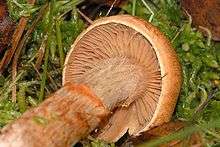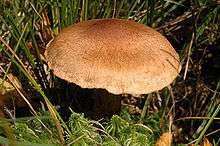Cortinarius armillatus
| Cortinarius armillatus | |
|---|---|
 | |
 | |
| Scientific classification | |
| Kingdom: | Fungi |
| Division: | Basidiomycota |
| Class: | Agaricomycetes |
| Order: | Agaricales |
| Family: | Cortinariaceae |
| Genus: | Cortinarius |
| Species: | C. armillatus |
| Binomial name | |
| Cortinarius armillatus (Fr.) Fr. [1838] | |
Cortinarius armillatus, commonly known as the red-banded cortinarius, is a late summer and autumn (as late as in October) fungus usually found in moist coniferous forests, especially spruced ones. The species grows rarely in North America, but is common in Europe.
Elias Magnus Fries described the species in 1838.[1]
The cap is bell shaped at first, later flattening out, vividly rust-brown becoming slightly paler with age, with small fibrous scales. The cap grows from 5 to 15 cm in diameter. The gills are dark rust-brown; broad, distant and shallowly sinuate. The spores are also rust-brown. The flesh is light brown.
Use
The fruit body has been found to contain orellanine, though at much lower concentrations than the lethal webcaps.[2]
When dyeing cloths, without added metals, it discharges pink, with tin yellow, with copper green and with iron olivic dyes.
References
- ↑ Cortinarius armillatus in MycoBank.
- ↑ Shao D, Tang S, Healy RA, Imerman PM, Schrunk DE, Rumbeiha WK (2016). "A novel orellanine containing mushroom Cortinarius armillatus". Toxicon. 114: 65–74. doi:10.1016/j.toxicon.2016.02.010.
Cortinarius armillatus in Index Fungorum
| Wikimedia Commons has media related to Cortinarius armillatus. |
- E. Garnweidner. Mushrooms and Toadstools of Britain and Europe. Collins. 1994.
- Sienestäjän käsikirja, ISBN 951-1-06264-6